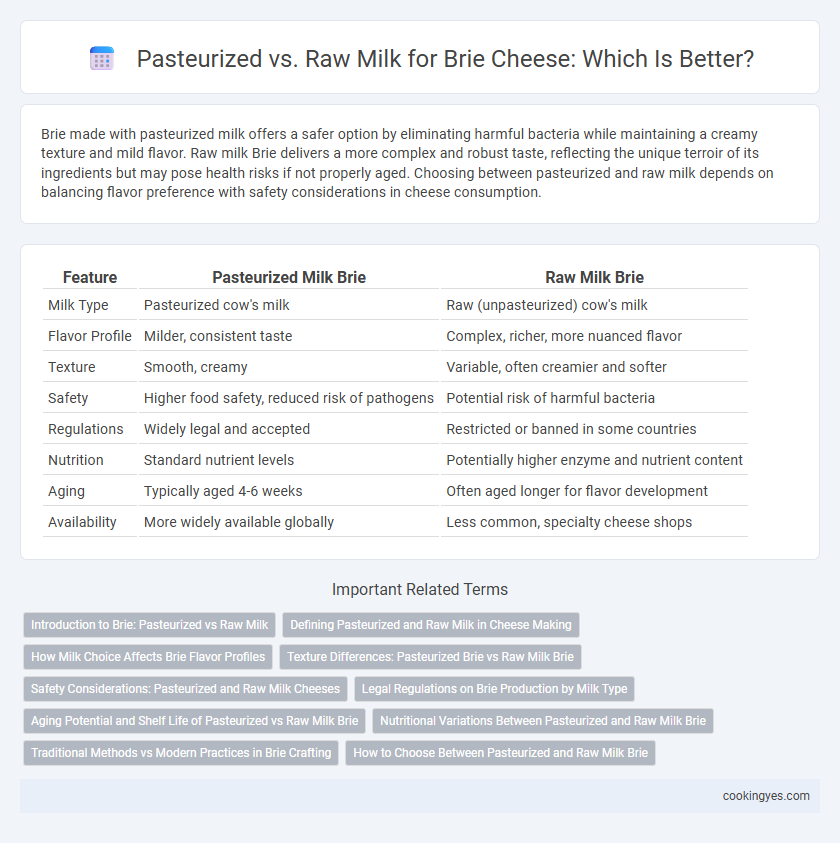Brie made with pasteurized milk offers a safer option by eliminating harmful bacteria while maintaining a creamy texture and mild flavor. Raw milk Brie delivers a more complex and robust taste, reflecting the unique terroir of its ingredients but may pose health risks if not properly aged. Choosing between pasteurized and raw milk depends on balancing flavor preference with safety considerations in cheese consumption.
Table of Comparison
| Feature | Pasteurized Milk Brie | Raw Milk Brie |
|---|---|---|
| Milk Type | Pasteurized cow's milk | Raw (unpasteurized) cow's milk |
| Flavor Profile | Milder, consistent taste | Complex, richer, more nuanced flavor |
| Texture | Smooth, creamy | Variable, often creamier and softer |
| Safety | Higher food safety, reduced risk of pathogens | Potential risk of harmful bacteria |
| Regulations | Widely legal and accepted | Restricted or banned in some countries |
| Nutrition | Standard nutrient levels | Potentially higher enzyme and nutrient content |
| Aging | Typically aged 4-6 weeks | Often aged longer for flavor development |
| Availability | More widely available globally | Less common, specialty cheese shops |
Introduction to Brie: Pasteurized vs Raw Milk
Brie cheese made from pasteurized milk offers a consistent flavor profile and enhanced safety by eliminating harmful bacteria, making it suitable for a wider range of consumers. Raw milk Brie provides a more complex and robust taste due to natural enzymes and microflora but requires careful aging to ensure safety. Understanding the differences in production methods helps cheese enthusiasts appreciate the nuances in texture, aroma, and flavor between pasteurized and raw milk Brie varieties.
Defining Pasteurized and Raw Milk in Cheese Making
Pasteurized milk, heated to eliminate harmful bacteria, ensures safety and consistency in Brie cheese production without significantly altering flavor. Raw milk, unheated and sourced directly from the animal, retains natural enzymes and microflora, contributing to Brie's complex, rich taste and texture. The choice between pasteurized and raw milk impacts the cheese's safety regulations, aging potential, and flavor profile.
How Milk Choice Affects Brie Flavor Profiles
Brie made from pasteurized milk often has a milder, creamier flavor with consistent texture due to the heat treatment eliminating harmful bacteria. Raw milk Brie, by contrast, offers a more complex, earthy, and robust flavor profile, influenced by the natural microflora preserved in unpasteurized milk. The choice between pasteurized and raw milk significantly impacts the Brie's aroma, taste intensity, and aging potential, with raw milk varieties typically prized for their depth and character.
Texture Differences: Pasteurized Brie vs Raw Milk Brie
Pasteurized Brie typically has a smoother, creamier texture due to the heat treatment that breaks down proteins, resulting in a more consistent and mild mouthfeel. Raw milk Brie retains a denser, more complex texture with varied curd structures, contributing to a richer, often earthier experience. The enzymatic activity preserved in raw milk enhances the cheese's depth and can create subtle grainy or crumbly textures absent in pasteurized versions.
Safety Considerations: Pasteurized and Raw Milk Cheeses
Pasteurized milk Brie undergoes heat treatment to eliminate harmful bacteria, ensuring a safer choice especially for pregnant women, young children, and immunocompromised individuals. Raw milk Brie, valued for its complex flavor profile, carries a higher risk of contamination with pathogens like Listeria monocytogenes if not produced under strict sanitary conditions. Regulatory agencies often enforce stringent safety standards on raw milk cheeses, mandating aging periods of at least 60 days to reduce microbial risks without compromising traditional taste.
Legal Regulations on Brie Production by Milk Type
Brie production is regulated differently depending on the milk type, with pasteurized milk Brie widely accepted under stringent food safety laws across the United States and Europe. Raw milk Brie faces more restrictive regulations, requiring extended aging periods, typically 60 days, to minimize microbial risks as mandated by the FDA and EU standards. Legal frameworks aim to ensure consumer safety while allowing artisanal producers to offer raw milk Brie that preserves traditional flavors and textures.
Aging Potential and Shelf Life of Pasteurized vs Raw Milk Brie
Raw milk Brie typically offers a more complex flavor profile and has a slightly longer aging potential due to the presence of naturally occurring enzymes and beneficial microbes that enhance maturation. Pasteurized milk Brie usually has a shorter shelf life and aging window because heat treatment reduces microbial diversity, leading to milder flavor development and quicker spoilage. Understanding these differences helps consumers and cheesemakers optimize storage conditions and aging time for desired taste and quality.
Nutritional Variations Between Pasteurized and Raw Milk Brie
Nutritional variations between pasteurized and raw milk Brie include differences in enzyme activity and microbial content, which affect flavor complexity and digestibility. Raw milk Brie typically contains higher levels of beneficial probiotics and natural enzymes that aid digestion, while pasteurized Brie has reduced microbial diversity due to heat treatment. Despite these variations, both types provide essential nutrients like calcium, protein, and vitamins B2 and B12 important for bone health and energy metabolism.
Traditional Methods vs Modern Practices in Brie Crafting
Pasteurized milk Brie undergoes heat treatment to eliminate harmful bacteria, ensuring safety and consistency in modern commercial production. Traditional Brie crafted with raw milk contains natural microflora that enhance complex flavors and textures, reflecting terroir and artisanal heritage. Regulations increasingly favor pasteurization for widespread distribution, yet raw milk Brie remains prized by connoisseurs seeking authentic, nuanced taste profiles.
How to Choose Between Pasteurized and Raw Milk Brie
Choosing between pasteurized and raw milk Brie primarily depends on flavor preferences and safety considerations. Raw milk Brie offers a richer, more complex taste due to natural enzymes and bacteria, while pasteurized Brie provides a milder flavor with reduced risk of harmful pathogens. Consumers should assess their tolerance for raw dairy and prioritize quality from reputable cheesemakers when selecting Brie.
Pasteurized vs Raw Milk for Brie Infographic

 cookingyes.com
cookingyes.com